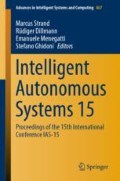Abstract
In this paper a method for detecting motion patterns and transitions between them in source code describing robotics tasks is proposed, being used to automatically generate flow diagrams of the corresponding task. This is done through the combination of both static and dynamic program analysis, first segmenting original code based on token matching and then using runtime data to judge importance of each segment and relations between them. Generation of flow diagrams is not only a simple way of visualizing overall procedure of complex tasks, but can also be used for current state identification and fail recovery systems. Proposed system is verified through experimentation using PR2 robot on the household task of cleaning up a table, being able to automatically generate a flow diagram with reasonable number of states.
Access this chapter
Tax calculation will be finalised at checkout
Purchases are for personal use only
References
Protsko, L.B., Sorenson, P.G., Tremblay, J.P., Schaefer, D.A.: Towards the automatic generation of software diagrams. IEEE Trans. Softw. Eng. 17(1), 10–21 (1991)
Furuta, Y., Inagaki, Y., Okada, K., Inaba, M.: Self-improving robot action management system with probabilistic graphical model based on task related memories. In: International Conference on Intelligent Autonomous Systems, pp. 811–823. Springer (2016)
Bryant, R.E.: Graph-based algorithms for Boolean function manipulation. IEEE Trans. Comput. 100(8), 677–691 (1986)
Minsky, M.L.: Computation: Finite and Infinite Machines. Prentice-Hall Inc., Hoboken (1967)
Böhm, C., Jacopini, G.: Flow diagrams, turing machines and languages with only two formation rules. Commun. ACM 9(5), 366–371 (1966)
Cheng, K.-T., Krishnakumar, A.S.: Automatic functional test generation using the extended finite state machine model. In: 30th Conference on Design Automation, pp. 86–91. IEEE (1993)
Burch, J.R., Clarke, E.M., McMillan, K.L., Dill, D.L.: Sequential circuit verification using symbolic model checking. In: Proceedings of the 27th ACM/IEEE Design Automation Conference, pp. 46–51. ACM (1991)
Boyer, R.S., Strother Moore, J.: A mechanical proof of the unsolvability of the halting problem. J. ACM (JACM) 31(3), 441–458 (1984)
Landi, W.: Undecidability of static analysis. ACM Lett. Program. Lang. Syst. (LOPLAS) 1(4), 323–337 (1992)
Cheng, K.-T., Krishnakumar, A.S.: Automatic generation of functional vectors using the extended finite state machine model. ACM Trans. Des. Autom. Electron. Syst. (TODAES) 1(1), 57–79 (1996)
Jou, J.-Y., Rothweiler, S., Ernst, R., Sutarwala, S., Prabhu, A.: Bestmap: behavioral synthesis from c. In: Proceedings of the International Workshop on Logic Synthesis (1989)
Costagliola, G., Tortora, G., Orefice, S., De Lucia, A.: Automatic generation of visual programming environments. Computer 28(3), 56–66 (1995)
Naebi, A., Khalegi, F., Hosseinpour, F., Zanjanab, A.G., Khoshravan, H., Kelishomi, A.E., Rahmatdoustbeilankouh, B.: A new flowchart and programming technique using bond graph for mechatronic systems. In: 2011 UkSim 13th International Conference on Computer Modelling and Simulation (UKSim), pp. 236–241. IEEE (2011)
Gusfield, D.: Algorithms on Strings, Trees and Sequences: Computer Science and Computational Biology. Cambridge University Press, New York (1997)
Open Source Robotics Foundation. smach - ROS Wiki. http://wiki.ros.org/smach
Author information
Authors and Affiliations
Corresponding author
Editor information
Editors and Affiliations
Rights and permissions
Copyright information
© 2019 Springer Nature Switzerland AG
About this paper
Cite this paper
de Campos Affonso, G., Okada, K., Inaba, M. (2019). Detection of Motion Patterns and Transition Conditions for Automatic Flow Diagram Generation of Robotic Tasks. In: Strand, M., Dillmann, R., Menegatti, E., Ghidoni, S. (eds) Intelligent Autonomous Systems 15. IAS 2018. Advances in Intelligent Systems and Computing, vol 867. Springer, Cham. https://doi.org/10.1007/978-3-030-01370-7_13
Download citation
DOI: https://doi.org/10.1007/978-3-030-01370-7_13
Published:
Publisher Name: Springer, Cham
Print ISBN: 978-3-030-01369-1
Online ISBN: 978-3-030-01370-7
eBook Packages: Intelligent Technologies and RoboticsIntelligent Technologies and Robotics (R0)

